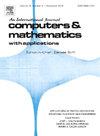Generalised adaptive cross approximation for convolution quadrature based boundary element formulation
IF 2.9
2区 数学
Q1 MATHEMATICS, APPLIED
引用次数: 0
Abstract
The acoustic wave equation is solved in time domain with a boundary element formulation. The time discretisation is performed with the generalised convolution quadrature method and for the spatial approximation standard lowest order elements are used. Collocation and Galerkin methods are applied. In the interest of increasing the efficiency of the boundary element method, a low-rank approximation such as the adaptive cross approximation (ACA) is carried out. We discuss a generalisation of the ACA to approximate a three-dimensional array of data, i.e., usual boundary element matrices at several complex frequencies. This method is used within the generalised convolution quadrature (gCQ) method to obtain a real time domain formulation. The behaviour of the proposed method is studied with three examples, a unit cube, a unit cube with a reentrant corner, and a unit ball. The properties of the method are preserved in the data sparse representation and a significant reduction in storage is obtained.
基于卷积正交边界元素公式的广义自适应交叉逼近
声波方程在时域中采用边界元素公式求解。时间离散采用广义卷积正交法,空间近似采用标准最低阶元素。采用了拼合和 Galerkin 方法。为了提高边界元方法的效率,我们采用了自适应交叉近似(ACA)等低阶近似方法。我们讨论了 ACA 的广义化,以近似三维数据阵列,即多个复频的常规边界元矩阵。这种方法被用于广义卷积正交(gCQ)方法中,以获得实时域公式。我们用三个例子研究了所提方法的性能,即一个单位立方体、一个带重入角的单位立方体和一个单位球。该方法的特性在数据稀疏表示中得以保留,并显著减少了存储量。
本文章由计算机程序翻译,如有差异,请以英文原文为准。
求助全文
约1分钟内获得全文
求助全文
来源期刊

Computers & Mathematics with Applications
工程技术-计算机:跨学科应用
CiteScore
5.10
自引率
10.30%
发文量
396
审稿时长
9.9 weeks
期刊介绍:
Computers & Mathematics with Applications provides a medium of exchange for those engaged in fields contributing to building successful simulations for science and engineering using Partial Differential Equations (PDEs).
 求助内容:
求助内容: 应助结果提醒方式:
应助结果提醒方式:


